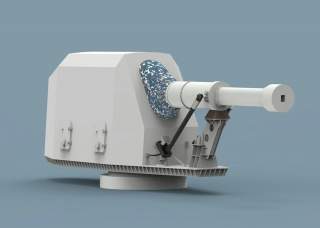RIP, U.S. Navy? Could China's Naval 'Railgun' Be Ready by 2025?
They might pull it off.
Key point: Beijing may end up beating America in building a working, viable naval railgun.
China could have the world’s most powerful naval gun by 2025, according to a U.S. intelligence report.
China is testing a ship-mounted railgun “capable of striking a target 124 miles away at speeds of up to 1.6 miles per second,” according to CNBC, citing anonymous sources familiar with the report.
“For perspective, a shot fired from Washington, DC could reach Philadelphia in under 90 seconds.”
A railgun is a sort of exotic cross between a catapult and a cannon, that uses electromagnetic energy instead of gunpowder to hurl projectiles at hypersonic speeds up to Mach 7. Electrical currents generate magnetic fields that accelerate a projectile along two rails. In theory, a railgun should be much cheaper than, say, a $1.4 million Tomahawk missile, which offers greater range but also can be shot down or jammed. A warship could also carry a huge number of small but high-velocity railgun projectiles
U.S. intelligence apparently possesses remarkably specific information, such as each Chinese railgun round costs between $25,000 and $50,000.
“China's railgun was first seen in 2011 and underwent testing in 2014,” sources told CNBC.
“Between 2015 and 2017 the weapon was calibrated to strike at extended ranges, increasing its lethality. By December 2017, the weapon was successfully mounted on a warship and began at-sea testing, a feat no other nation has accomplished.”
America has been working on its own railgun for more than a decade. The flagship project is the Electromagnetic Railgun Innovative Naval Prototype, launched in 2005 by the U.S. Navy’s Office of Naval Research. The goal was to develop a weapon with a muzzle velocity of thirty-two megajoules and a range of one hundred miles.
The U.S. Army is also now interested in railguns. In March 2018, General Atomics announced that it had been awarded a three-year Army contract to develop an electromagnetic weapon.
“The railgun weapon system is intended to integrate with existing Army systems and complement conventional capabilities, providing an effective counter to aircraft, rocket and cruise missile raids as well as other threats,” said a General Atomic executive.
With its aura of science-fiction high-tech—imagine invisible streams of energy accelerating bullets as if by magic—railguns do fire the imagination.
“The railgun is a true warfighter game-changer,” extolled ONR’s Web page.
“Wide-area coverage, exceptionally quick response and very deep magazines will extend the reach and lethality of ships armed with this technology.”
But not so fast. Late last year, Task and Purpose suggested that the Navy was cutting back on funding for naval railgun research, in favor of other technologies such as lasers and hypervelocity projectiles that can be fired from conventional cannon.
For all their exotic lure, railguns have problems given the current state of technology. The biggest is one symptomatic of modern technological society, which is that electricity is everything. Generating those electromagnetic fields requires a lot of juice.
“Few warships have the spare electrical capacity the weapon requires. The strongest candidate is the USN’s Zumwalt-class destroyer, whose 78MW [megawatt] integrated power system can dynamically distribute power between propulsion and on-board systems,” explains one article.
“It should have about 58MW of reserve power while steaming at 20 knots. By comparison, the Arleigh Burke-class destroyer has only 7.5MW for on-board systems.”
For the Army, a land-based system would require sufficient power, presumably from a mobile source if it were to accompany troops rather than just guard installations. The same issue also bedevil laser weapons, which entails research into power generation as well as battery storage.
So has China made a breakthrough to make shipboard electromagnetic weapons feasible? That possibility can't be ruled out: China is growing stronger technologically with every passing year, or it might have allocated more funding toward railgun research.
But it seems just as likely that China wants railguns because America wants railguns. As we know from the Cold War, keeping up with the Joneses—or the Wangs—can leave both parties with expensive gear they never really needed.
Michael Peck is a contributing writer for the National Interest. This first appeared in July 2018.
Image: Twitter.

